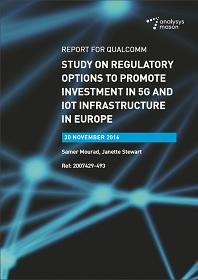Regulatory options to promote investment in 5G and IoT infrastructure in Europe
 The vision for 5G is that networks will seamlessly support a diverse range of future connected devices, services and industries. In doing so, 5G will take the business case for mobile infrastructure investment significantly beyond the scope of today’s consumer-driven mobile broadband services, towards support for a diverse range of use cases across multiple European industries including the ‘Internet of Things’ (IoT). With this potentially wide-ranging scope for connecting people, places and things, European policy makers envisage that 5G will lie at the heart of our future digital economy and society.
The vision for 5G is that networks will seamlessly support a diverse range of future connected devices, services and industries. In doing so, 5G will take the business case for mobile infrastructure investment significantly beyond the scope of today’s consumer-driven mobile broadband services, towards support for a diverse range of use cases across multiple European industries including the ‘Internet of Things’ (IoT). With this potentially wide-ranging scope for connecting people, places and things, European policy makers envisage that 5G will lie at the heart of our future digital economy and society.
However, it will potentially be challenging for operators to invest in networks to cater for all use cases (and precise user requirements), and hence it is important for policy and regulatory frameworks for 5G to support a variety of business models.
An issue for Europe is that strong competition in mobile infrastructure (as promoted by regulatory frameworks to date) has resulted a steady decline in monthly average revenue per user (ARPU) since around 2011, such that European ARPUs are low by international comparison. There is no indication of this trend reversing as 4G services evolve. The lower ARPUs associated with mobile services in Europe, combined with other trends such as reduction in mobile termination rates, are key factors affecting mobile revenues across European markets. Future mobile network investment must therefore be considered in the context of these lower revenues. Cost-efficiency measures such as network sharing and network mergers are evidence of operator’s desires to reduce network costs in highly competitive markets.
Until 5G networks move closer towards commercial roll-out, it will remain unclear how services are to be priced. Nevertheless, it is possible that the scale of network investment needed to achieve all the use cases and services being envisaged for 5G may bring radical shifts, if not in pricing, in market structure. Analysys Mason has investigated the feasibility of a range of investment cases for 5G, including to meet IoT requirements, in a recent study conducted on behalf of Qualcomm. The study considers the deployment of next-generation mobile broadband services along with deployment of 5G in selected industry verticals.
The study has found that if mobile operators maintain current levels of investment (c. EUR40 per population and per year for overall mobile network investments in a European country), an average operator would reach circa EUR13 billion, EUR22 billion and EUR13 billion in France, Germany and UK respectively of total investments in 5G over a 20 years’ period (2020 to 2040) to deliver around 72% of population with 5G in Germany and France, reaching 82% of population in the UK. More optimistic assumptions on ARPU would improve the profitability of the business cases. This could, under the appropriate regulatory conditions, result in additional investment being targeted at improving the coverage reach of 5G networks.
Infrastructure sharing also makes a positive difference to the business case and can extend coverage by up to 25% (achieving close to 100% population coverage). Deeper levels of sharing (e.g. the sharing of spectrum) might improve this situation further.
DOWNLOAD REPORT
This report, conducted on behalf of Qualcomm, looks at the feasibility of a range of investment cases for 5G, including to meet IoT requirements.
Download your free copyAuthors

